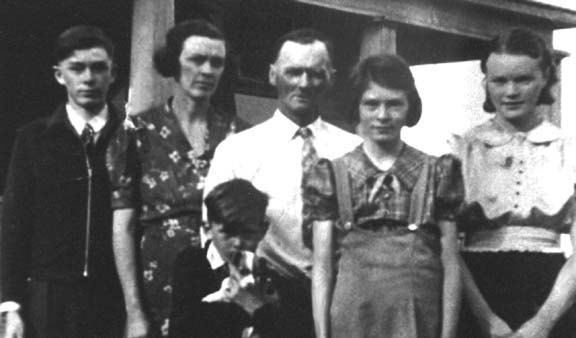|
The Anglo-Saxons
|
 |
| FTLComm - Tisdale - March 22, 2001 |
| |
There would have been a time when the English might have been the major in Saskatchewan
but that was probably only for a short while after it had become a province. English
settlement flowed across the country from Ontario and in many cases stopping along
the way in Manitoba. This was the case with my mother's family, the Fisks, who came
to Saskatchewan via Orangeville Ontario, then to near Virden Manitoba then to South
of Moosomin settling in the Raga district North of Kelso. |
| |
|
| |
My grandfather came from England in 1912 having chosen the correct boat as he left
his home near the Sherwood Forest and set out to find his older bothers who had come
to Canada seeking their fortune. He got off the train in Kelso and went to work for
what would become his father-in-law Andy McVicar. |
| |
|
| |
The South Eastern portion of Saskatchewan was first settled along with the villages
that grew up along the main line CPR. These communities and those and the South East
were made up mostly of English settlers. One of the first European Saskatchewan settlements
was indeed an oddity that took place at Cannington
Manor. Situated just South of the Moose Mountains and the already established Sauteaux
(Anicinabe) and Bakota (Assiniboine) settlement know as the White Bear. |
| |
|
| |
It was 1883 when Andrew McVicar and his father and brother Jack came to Saskatchewan
from Manitoba. Andrew established a homestead East of Kelso while brother Jack went
seven miles West to establish a homestead at Vandura. Their parents graves are at
the a small cemetery North of Vandura called Earlswood. Andrew and his bride did
not find farming an easy task and from his missing toes it was a sure thing that
Andrew was less than a skilled individual with an axe. However, his picture can be
clearly seen on the wall in the Cannington Manor museum as the barehanded back catcher
for the baseball team. |
| |
|
| |
Cannington was a hair brained scheme that saw a number of English gentlemen establish
proper estates including riding stables and race tracks out in the Wilds of the Canadian
prairie. Hoping to finance the project by raising hogs on a big scale the collection
of estates was to provide a place for young English gentlemen to have someplace to
go. England at the time the Bronte girls were writing their books had far to many
young men and not enough wars. Young gentlemen would not inherit the family estates
because they were not the eldest and so off to Canada to "Make something of
themselves." |
| |
|
| |
Though this was a small settlement it was established and around it soon developed
a whole network of villages and English communities. From Oxbow to Alemada and West
to Weyburn and North to the CP mainline this was most British countryside. Moosomin,
Whitewood, Broadview, Grenfell, Wolsley and Indian Head all have the look of towns
just like them in Manitoba and Ontario. Stone houses, lots of trees and a sense of
British Victorian architecture Regina, Moose Jaw, Swift Current and Maple Creek all
share a common time of being established and everyone has similar houses built at
that time. |
| |
|
| |
The English also began what would become Saskatchewan's college town as the Barr
colony of sober no-liquor religious folks set up their little settlement on the big
bend on the South Saskatchewan River |
| |
|
| |
While they were getting themselves organised the Pearson Land company working out
of Regina was selling the land on the West side of Last Mountain Lake in the area
known as Palisar's triangle. Many of the buyers would be Englishman. |
| |
|
| |
As settlement fanned out across the nearly empty plains the English were there in
equal numbers with other new comers and their names live on in every phone book in
the province. |